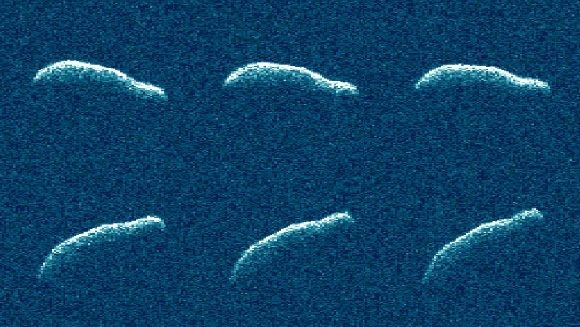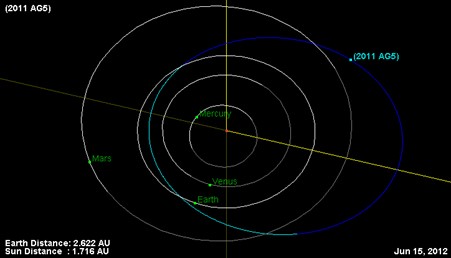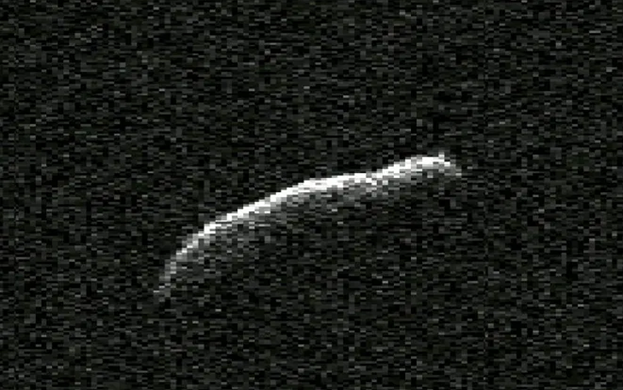by Rida Fatima

(Fig 1: The asteroid 2011 AG5’s close approach to Earth on February 3 was captured in a collage of six planetary radar observations (Image credit: NASA/JPL-Caltech).)
A group of astronomers recently had the opportunity to closely examine a potentially dangerous asteroid as it passed by Earth. The asteroid, named 2011 AG5, caught their attention because it is elongated and rotating more slowly than expected. This asteroid was first discovered by the Mount Lemmon Survey in Arizona in 2011, and at the time, it made headlines because it was predicted to be on a dangerous trajectory towards Earth in 2040 due to its orbit around the sun taking about 621 days. However, upon conducting further research back in 2012, astronomers discovered the error in the calculation of its orbit, and that it does not actually threaten Earth. Despite not posing a threat, the anomaly of this asteroid has caught the attention of astronomers, who are interested in studying it further to better understand its unusual shape and rotation (Baker, 2023).
On February 3, 2023, an asteroid passed by Earth at a distance of around 1.1 million miles (1.8 million kilometers), which is approximately five times as far as the moon is from Earth. This close proximity to our planet gave astronomers an opportunity to observe and scan it in detail for the first time. Prior to this close flyby, scientists had limited information about the asteroid’s characteristics and properties, but this new observation could provide valuable insights. By closely studying the asteroid’s composition, shape, and rotation, researchers can gain a better understanding of its origins, and potentially learn more about the history and evolution of our solar system. The close encounter also allowed astronomers to confirm that the asteroid is not on a collision course with Earth, giving us a sense of relief that there is no immediate threat from this particular space rock.
Unusual Characteristics of Asteroid 2011 AG5 During Close Flyby of Earth

(Fig 2: Asteroid 2011 AG5’s orbit and current location as of June 15, 2012 (Image credit: NASA/JPL-Caltech).)
A study conducted by researchers using NASA’s Deep Space Network facility in California has shed new light on the characteristics of asteroid 2011 AG5. The scientists used a powerful Goldstone Solar System Radar antenna dish to capture images of the asteroid during its close flyby of Earth on February 3, 2023. The images revealed that the asteroid is approximately 500 meters long and 150 meters in width, it can be estimated as big as the Empire State Building in size. What surprised the researchers was the unusual elongated shape of the asteroid, which is unlike most other near-Earth objects that have been observed to date. Lance Benner, a principal scientist at NASA’s Jet Propulsion Laboratory, lead the research with his expertise, commented that “this is one of the most elongated near-Earth objects we’ve seen out of the 1,040 near-Earth objects that planetary radar has detected so far”.
Despite the surprising discovery, the scientists are not jumping to any conclusions about why the asteroid has such an unusual and unexpected size and shape until they have more time to dig into the information. The findings from this observation has the complete potential to provide new insights into the formation and evolution of asteroids in our solar system, and perhaps even help us better understand the threat posed by potentially hazardous near-Earth objects.
New Radar Scans Reveal Slow Rotation and Surface Features of Asteroid 2011 AG5

(Fig 3: One of the radar observations of the asteroid. (Image credit: NASA/JPL-Caltech).)
The recent radar scans of asteroid 2011 AG5 conducted by NASA’s Deep Space Network facility have revealed new insights about its rotation and surface features. According to the scans, the asteroid takes around 9 hours for the completion of its single rotation, it is considered a much longer time as compared to other asteroids. The elongated shape of the asteroid may have an influence on its slow rotation, although the exact reason is not clear. The surface of the asteroid was visible in dark and light patches in the new images, which would point to the presence of numerous small-scale features on the body of the asteroid. However, the researchers are uncertain about what these features are. The scientists hope that the new data collected from the radar scans will enable them to better predict the asteroid’s future trajectory, which could help to explain its unusual characteristics (Shawn, 2023).
The latest ranging calculations obtained by the team working on the planetary radar system will help researchers to better predict the asteroid’s trajectory and track its movements, particularly when it passes closer to Earth in 2040. The director of NASA’s Center for Near Earth Object Studies (CNEOS) – Paul Chodas at JPL, emphasized that new data will provide more insights into the asteroid’s properties and definitely maximize the opportunities to better understand this peculiar space rock. Moreover, the asteroid is not considered a direct threat to Earth, because of its size and closeness to earth it is taken as a “potentially hazardous asteroid” it will pass within 1.1 million km of Earth during its next flyby in 2040. As such, it is essential for astronomers to continue monitoring the asteroid’s movements and studying its characteristics to better understand the potential risks posed by other near-Earth objects in the future.
Reference
- Baker, H. (2023, February 24). Potentially hazardous asteroid that recently zipped past Earth is an elongated weirdo with an odd rotation. Retrieved from https://www.livescience.com/potentially-hazardous-asteroid-that-recently-zipped-past-earth-is-an-elongated-weirdo-with-an-odd-rotation
- Shawn, A. “‘Potentially Hazardous’ Asteroid That Recently Zipped Past Earth Is an Elongated Weirdo With an Odd Rotation – Verve Times.” Verve Times, 21 Feb. 2023, https://vervetimes.com/potentially-hazardous-asteroid-that-recently-zipped-past-earth-is-an-elongated-weirdo-with-an-odd-rotation
